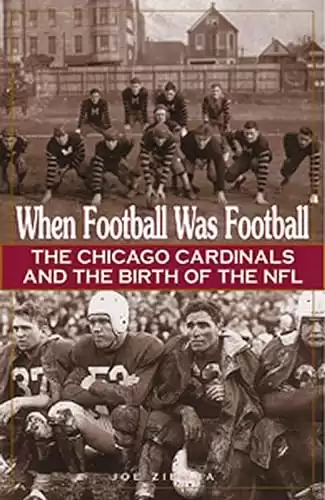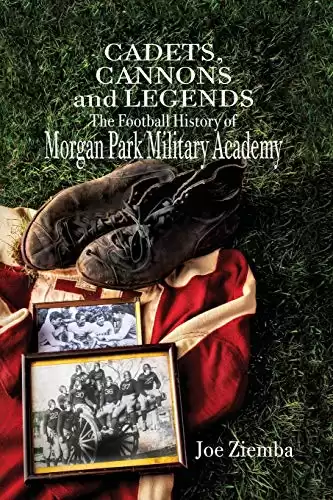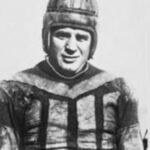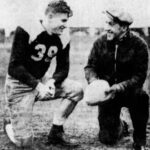It began over 100 years ago. An intense rivalry between two NFL teams like no other. Gunshots, riots, broken noses, stolen players, verbal sparring, and lost championships.
They would argue over ineligible players, the height of the grass on a field, suspected spies watching their practices, and even the quality of post-game meals hosted by the home team. The battles raged for forty years, with each game seeming to bring out the best (or worst) on both sides until suddenly it was over. And even the reason for that disruption was embroiled in controversy.
On November 28, 1920, the Chicago Cardinals (5-1-1) edged the undefeated Decatur Staleys (9-0-1) 7-6 to ignite the NFL’s oldest rivalry. Of course, the teams today are known as the Arizona Cardinals and the Chicago Bears and they remain as the only two original franchises still active in the National Football League.
The Chicago Tribune provided some notice of the professional contest in a sport that had yet to attract the full support of sports fans: “The crack Staley team from Decatur, who claim the Midwest title, will appear at Normal Park as the opponents of the Cardinals. The down staters have not been defeated since they were organized early in the fall, while the only black mark on the record of the Cards is a setback at Rock Island.”
First Game Ends In Controversy
That first game set the tone for the often bitter future meetings between the two clubs when the Cardinals escaped with that narrow victory over the protests of the Decatur player/coach George Halas. In a game set at tiny Normal Park, the home of the Cardinals on Chicago’s south side, the hosts managed to grab the victory after Decatur scored on the opening kickoff.
That opening kick glanced off a Cardinals’ return man and right into the anxious arms of the approaching Bob Koehler of the Staleys, who scooped up the ball and ran it into the end zone. A missed extra point kick by the usually reliable Hugh Blacklock left the Staleys ahead 6-0 with just seconds gone on the clock.
Neither team would score again until early in the third period when Lenny Sachs of the Cardinals picked up an errant fumble on the Staleys’ 20 yard-line and ran it in for the tying touchdown. Paddy Driscoll’s dropkick for the extra point provided the game-winning difference in the Cardinals’ 7-6 victory.
There was some controversy regarding that play, however, as Coach George Halas of the Staleys contended that the scoring return by Sachs was enabled by fan interference near the goal line. Over 5,000 attendees crammed into Normal Park that day and many who could not locate a seat moved towards standing room positions adjacent to the field.
It was in this area that Halas aimed his complaint, claiming that Sachs was surrounded by local well-wishers who interfered with the Staleys’ defenders on the play.
Sportswriter Red Smith recalled the dismay of Halas in a column written many years later:
“George’s eyes still flash when he remembers how a referee robbed the Bears in 1920 when they were the Decatur Staleys. The Staleys were leading the Racine Cardinals 6-0 late in the game when the Cardinals [runner] ducked behind a knot of spectators who had crowded onto the field and with his civilian interference ran in for a touchdown. Not wishing to become suddenly dead, the referee allowed the score.”
Biggest Surprise Of Season
The Chicago Herald-American was thrilled with the outcome stating: “Chris O’Brien’s Chicago Cardinals sprang the biggest surprise of the local football season when they walloped the hitherto undefeated Staleys of Decatur in a thrilling 7-6 contest at Normal Park. More than 5,000 fans saw the pastime, which was as full of football strategy and skill as three ordinary contests.”
The Staleys and the Cardinals had so much fun that they quickly agreed to meet once again a week later with the Staleys hosting the battle at Cubs Park (now known as Wrigley Field) on the north side of Chicago.
The rematch was a stunning success for early pro football in Chicago as over 11,000 attended the game—the largest crowd yet to see a professional game in the Windy City. Halas and the Staleys extracted a measure of revenge in the game by escaping with a 10-0 win over the Cardinals, who were betrayed by the loss of their top players, Paddy Driscoll and Lenny Sachs, due to injuries early in the game.
The pair of games between the Staleys and the Cardinals in 1920 were just the start of a long and intriguing rivalry that will be renewed again on December 5 of this year. However, the bright lights of the rivalry diminished greatly when the Cardinals moved to St. Louis in 1960, and the teams no longer locked horns on an annual basis.
Still, these two founding members of the NFL were the first to meet among the current NFL membership with the Cardinals and the Green Bay Packers owning the second-oldest rivalry beginning on November 20, 1921. The Bears and the Packers rivalry is the third oldest in history, going back to November 27, 1921.
Traditionally, the Bears and the Cardinals would meet at least twice per year beginning in 1920, and sometimes played three contests during a season. When the league finally split into more formal divisions in the 1950s, and the Chicago clubs were placed in different divisions, the teams played just a single game from 1953 through 1959.
Capone Gang Interrupts Game
But it was the early days that ignited the passion, competition, and spirit between the two neighboring teams. Previously in an episode of “When Football Was Football,” we covered the 1922 contest that was delayed when members of the Al Capone gang interrupted the game after a fight broke out between the teams following a harsh tackle on Cardinals’ superstar Paddy Driscoll.
George Halas was one of the aggressors in that situation and he was also knocked out during the ensuing fray, awakening to find himself straddled by an exuberant fan with a pistol held against the head of Halas! Basically, fights were considered as much a part of the Bears-Cardinals clashes as the games themselves. It was not uncommon for battles to break out before, during, and after games between these two heated rivals.
In 1925, the great Red Grange signed with the Bears following the last game of his collegiate season. His first professional game was against the Cardinals who were wary of the capabilities of Grange. Paddy Driscoll punted away from Grange throughout the scoreless tie in front of a sell-out crowd in Chicago leading to a chorus of boos as Driscoll and Grange walked off the field together.
At this point, Driscoll said to his wife: “It’s too bad the fans are booing young Grange. We didn’t give him a chance to do much with the ball today.” It was then his wife replied: “They’re not booing Red, dear. They’re booing you for keeping the ball away from him!”
Nevers Establishes Scoring Record
Two of the games in the late 1920s were historically important in the rivalry. In 1928, owner Chirs O’Brien of the Cardinals signed up the legendary Jim Thorpe to play for the Cardinals against the Bears.
While Thorpe had no impact on the game, his appearance marked the last time that Thorpe would play in an NFL contest. Then in 1929, Ernie Nevers, behind the savage blocking of Duke Slater, scored all of the Cardinals’ points in a 40-6 blasting of the Bears. The 40 points remains today as the most points scored by an individual in an NFL game.
During the 1930s, both the Bears and the Cardinals shared Wrigley Field in Chicago. By this time, both teams were struggling to survive the Great Depression and the Cardinals lagged in attracting fans to Comiskey Park on the south side of Chicago.
The Bears, meanwhile, did enjoy much stronger attendance on the north side. Naturally, the Cardinals thought that they could duplicate this fan interest simply by moving into the cozy arrangement with the Bears. It didn’t work, but the Cardinals spent the entire decade at Wrigley Field before heading back south in 1940.
While the Bears won NFL titles in 1921, 1932, 1933, 1940, 1941, 1943, and 1946, the Cardinals secured only one championship, and that was in 1925. However, following WWII, the Cardinals rebounded and grabbed the 1947 crown after defeating the Bears for the western title, using a trick play to score on the opening series.
The idea was to isolate speedy Babe Dimancheff on a slower Bears linebacker. However, Babe’s wife was expecting a child the week before the game and Babe spent several nights sleeping on a folding chair in the hospital and was unable to practice the special play. Yet, the Cardinals were still able to pull it off and the team went on to defeat the Bears 30-21 and then knocked off the Eagles 28-21 for the NFL title.
New Football Book Announcement
During the 1950s, both teams struggled without a title, but the Cardinals succeeded in upsetting the Bears a couple of times to extinguish the championship hopes of the north siders. Finally, in March of 1960, the Cardinals, with more than a little nudge from George Halas, moved to St. Louis, thus softening the most intense rivalry in the NFL at the time.
The players involved with both the current Bears and Cardinals squads will probably not recognize the names, the results, or the early battles between the oldest NFL rivals. After all, the Cardinals left Chicago over 60 years ago and precious few can boast that they even attended one of the Cardinals games back then.
But the history those two Chicago teams left behind can never be forgotten. So, here’s our special message promised at the beginning of this episode. I’m very pleased and honored, to announce that my new book called Bears vs. Cardinals: The NFL’s Oldest Rivalry will be published by our friends at McFarland Books during the spring of 2022.
For those who love the history of pro football, this book may grab your attention since it includes information and photos never seen before about the legendary histories of both the Bears and the Cardinals. Primarily, the assets of the Dutch Sternaman collection are used heavily allowing us to eavesdrop on Bears’ scouting reports, expenses, salaries, and contracts.
We also question the history of both teams and explain why and how the stories about the origins of the Cardinals’ name and the team’s starting date are incorrect. And did you know that George Halas might not have left Decatur voluntarily?
The book includes over 20 interviews with key football personnel and over 100 newspapers and private collections were used as resources in the development of this project. We do hope that you will discover many football surprises and also take a peek at the high school career of George Halas which had not been previously documented.
The focus begins in 1899 and concludes in 1960 when the Cardinals left Chicago. While the two teams no longer play each other every season, the intent of The NFL’s Oldest Rivalry is to retain and remember the history and the heroes who helped make pro football the beloved game that it is today.
Thank you for joining us for this episode of “When Football Was Football” and watch for our next program which will put you on the train for those long road trips in the NFL of the 1940s. The players really did object to being forced to work on tackling dummies in the baggage car while dressed in their traveling dress suits with no available showers!
Author and Host - Joe Ziemba
Joe Ziemba is the host of this show, and he is an author of early football history in the city of Chicago. Here, you can learn more about Joe and When Football Was Football, including all of the episodes of the podcast.
Please Note – As an Amazon Associate I earn from qualifying purchases
Resources
More From When Football Was Football
Paddy Driscoll’s Almost Perfect Season
Back at the beginning of the National Football League in...
Read More120,000 Fans Witness High School Football Game in 1937!!!
Let’s set the stage… It was a warm November afternoon...
Read MoreIn The Beginning: An Interview With Joseph T. Sternaman
And, you may ask, who is Joseph T. Sternaman? Sternaman...
Read More1948: The Last Hurrah of the Chicago Cardinals
Cardinals’ fans are familiar with the long, sad story concerning...
Read More





1 thought on “Bears vs. Cardinals: NFL’s Oldest Rivalry”